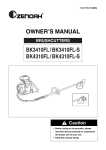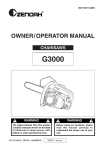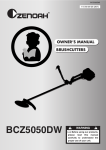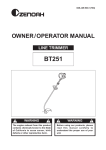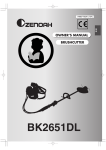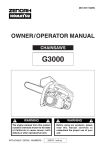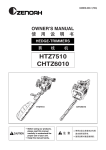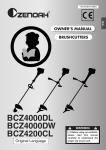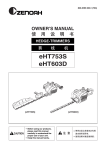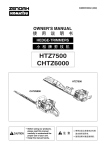Download Zenoah BK3410FL Owner`s manual
Transcript
848-KD6-93A1 (806) OWNER’S MANUAL BRUSHCUTTERS BK3410FL BK4310FL Caution • Before using our brushcutter, please read this manual carefully to understand the proper use of your unit. • Keep this manual handy. SAFETY FIRST Instructions contained in warnings within this manual marked with a symbol concern critical points which must be taken into consideration to prevent possible serious bodily injury, and for this reason you are requested to read all such instructions carefully and follow them without fail. ■ NOTES ON TYPES OF WARNINGS IN THE MANUAL WARNING This mark indicates instructions which must be followed in order to prevent accidents which could lead to serious bodily injury or death. IMPORTANT This mark indicates instructions which must be followed, or it leads to mechanical failure, breakdown, or damage. NOTE This mark indicates hints or directions useful in the use of the product. Contents 1. 2. 3. 4. 5. 6. 7. 8. 9. 10. 2 WARNING LABELS ON THE MACHINE ………3 SYMBOLS ON THE MACHINE …………………3 SAFETY PRECAUTIONS …………………………4 SET UP ……………………………………………9 FUEL ………………………………………………13 OPERATION………………………………………14 MAINTENANCE …………………………………17 STORAGE…………………………………………20 DISPOSAL ………………………………………20 SPECIFICATIONS ………………………………20 1. WARNING LABELS ON THE MACHINE (1) Read owner's manual before operating this machine. (2) Wear head, eye and ear protection. (3) Warning/Attention (4) Keep all children, bystanders and helpers 15 meters away from the brushcutter IMPORTANT If warning seals peel off or become soiled and impossible to read, you should contact the dealer from which you purchased the product to order new seals and affix the new seal(s) in the required location(s). WARNING Never remodel your brushcutter. We won't warrant the machine, if you use the remodeled brushcutter or you don't observe the proper usage written in the manual. 2. SYMBOLS ON THE MACHINE For safe operation and maintenance, symbols are carved in relief on the machine. According to these indications, please be careful not to take a mistake. (a) The port to refuel the "MIX GASOLINE" Position: FUEL TANK CAP (b) The direction to close the choke Position: AIR CLEANER COVER (c) The direction to open the choke Position: AIR CLEANER COVER 3 3. SAFETY PRECAUTIONS ■ BEFORE USING THE MACHINE a. Read this owner's manual carefully to understand how to operate this unit properly. b. This product has been designed for use in cutting grass, and it should never be used for any other purpose . c. You should never use this brushcutter when under the influence of alcohol, when suffering from exhaustion or lack of sleep, when suffering from drowsiness as a result of having taken cold medicine, or at any other time when a possibility exists that your judgment might be impaired or that you might not be able to operate the brushcutter properly and in a safe manner. d. Avoid running the engine indoors. The exhaust gases contain harmful carbon monoxide. e. Never use your brushcutter under circumstances like those described below: 1. When the ground is slippery or when other conditions exist which might make it not possible to maintain a steady posture while using the brushcutter. 2. At night, at times of heavy fog, or at any other times when your field of vision might be limited and it would be difficult to gain a clear view of the area. 3. During rain storms, during lightning storms, at times of strong or gale-force winds, or at any other times when weather conditions might make it unsafe to use this product. f. When using this product for the first time, before beginning actual work, learn to handling the brushcutter from skilled worker. g. Lack of sleep, tiredness, or physical exhaustion results in lower attention spans, and this in turn leads to accidents and injury. Limit the amount of time over which the brushcutter is to be used continuously to somewhere around 30~40 minutes per session, and take 10~20 minutes of rest between work sessions. Also try to keep the total amount of work performed in a single day under 2 hours or less. h. Be sure to keep this manual handy so that you may refer to it later whenever any questions arise. i. Always be sure to include this manual when selling, lending, or otherwise transferring the ownership of this product. j. Never allow children or anyone unable to fully understand the directions given in this manual to use this brushcutter. 4 3. SAFETY PRECAUTIONS ■ WORKING GEAR AND CLOTHING a. When using your brushcutter, you should wear proper clothing and protective equipment as follows. (1) (2) (3) (4) (5) Helmet Protection goggles or face protector Thick work gloves Non-slip-sole work boots Ear protectors b. And you should carry with you. 1. Attached tools and files 2. Properly reserved fuel 3. Spare blade 4. Things to notify your working area (Rope, warning signs) 5. Whistle (for collaboration or emergency) 6. Hatchet or saw (for removal of obstacles) c. Never use your brushcutter when wearing pants with loose cuffs, when wearing sandals, or when barefoot. ■ WARNING CONSIDERING HANDLING OF FUEL a. The engine of this product is designed to run on a mixed fuel which contains highly flammable gasoline. You should never store cans of fuel or refill the fuel tank in any place where there is a boiler, stove, wood fire, electrical sparks, welding sparks, or any other source of heat or fire which might ignite the fuel. b. Smoking while operating the brushcutter or refilling its fuel tank is extremely dangerous. Always be sure to keep lit cigarettes away from the brushcutter at all times. c. When refilling the tank always turn off the engine first and take a careful look around to make sure that there are no sparks or open flames anywhere nearby before refueling. d. If any fuel spillage occurs during refueling, use a dry rag to wipe up spills before turning the engine back on again. e. After refueling, screw the fuel cap back tightly onto the fuel tank and then carry the brushcutter to a spot 3m or more away from where it was refueled before turning on the engine. 5 3. SAFETY PRECAUTIONS ■ THINGS TO CHECK BEFORE USING YOUR BRUSHCUTTER a. Before beginning work, look around carefully to get a feel for the shape of the land, or grass to be trimmed, and whether or not there are any obstacles which might get in the way while working, and remove any obstacles which can be cleared away. b. The area within a perimeter of 15m of the person using the brushcutter should be considered a hazardous area into which no one should enter while the brushcutter is in use, and when necessary yellow warning rope, warning signs should be placed around the work area. When work is to be performed simultaneously by two or more persons, always check the presence and locations of others so as to maintain a distance each person sufficient to ensure safety. c. Make sure that there are no loose screws or bolts, fuel leaks, ruptures, dents, or any other problems which might interfere with safe operation. Be especially careful to check that there is nothing wrong with the blades or with the joints by which the blades are attached to the brushcutter. d. Never use blades that are bent, warped, cracked, broken or damaged in any way. e. Keep the blade always sharp. f. Filing the cutting edges, keep the end corner sharp and round the root of the edge. g. Check the bolt to fasten the blade and be sure the blade turns smoothly without abnormal noise. ■ NOTES ON STARTING THE ENGINE 1. Take a careful look around to make sure that no obstacles exist within a perimeter of 15m or less around brushcutter. 2. Place the body of the brushcutter onto the ground in a flat clear area and hold it firmly in place so as to ensure that neither the blades nor the throttle come into contact with any obstacles when the engine starts up. 3. Place the throttle into the idling position when starting the engine. 4. After starting up the engine, if the blades continue to rotate even after the throttle has been moved fully back, turn off the engine and check the throttle wire and other parts. 6 3. SAFETY PRECAUTIONS ■ KICKBACK SAFETY PRECAUTIONS • A dangerous reaction may occur when the spinning blade contacts a solid object in the critical area. It is called Kick back. As a result, the operator can lose control of the unit which can cause serious or fatal injury. Avoid kickback, observe the safety precautions below strictly. 1. Before beginning work, clear your working area and remove grasses around the obstacles. 2. When using your brushcutter, do not grip other parts except the handles. 3. When using your brushcutter, never take your eyes off. If you need to, place the throttle into the idling position. 4. When using your brushcutter, do not let the unit get closer to your feet nor raise the unit above your waist. ■ NOTES ON TRANSPORTATION a. Make sure the appropriate blade cover is in place. b. When transporting by car, fix the unit firmly using a rope. Do not transport by bicycle or motorbike because it is dangerous. c. Never transport the brushcutter over rough roads over long distances without first removing all fuel from the fuel tank, as doing so might cause fuel to leak from the tank. ■ OPERATION SAFETY PRECAUTIONS a. Grip the handle and grip of the brushcutter firmly with both hands. If you suspend the work, place the throttle into the idling position. b. Always be sure to maintain a steady, even posture while working. c. Maintain the speed of the engine at the level required to perform cutting work, and never raise the speed of the engine above the level necessary. d. If the grass gets caught in the blade during operation, or if you need to check the unit or refuel the tank, always be sure to turn off the engine. e. If the blade touches a hard object like a stone, immediately stop the engine and check if something is wrong with the blade. If so, replace the blade by new one. f. If someone calls out while working ,always be sure to turn off the engine before turning around. g. Never touch the spark plug or plug cord while the engine is in operation. Doing so may result in being subjected to an electrical shock. h. Never touch the muffler, spark plug, or other metallic parts of the engine while the engine is in operation or 7 3. SAFETY PRECAUTIONS immediately after shutting down the engine. Doing so may result in serious burns. i. When you finish cutting in one location and wish to continue work in another spot, turn off the engine and turn the unit as the blade faces away from your body. ■ MAINTENANCE SAFETY PRECAUTION a. Perform the maintenance and checking operations described in this manual at regular intervals. If any parts must be replaced or any maintenance or repair work not described in this manual must be performed, please contact a representative from the store nearest ZENOAH authorized servicing dealer for assistance. b. Under no circumstances should you ever take apart the brushcutter or alter it in any way. Doing so might result in the brushcutter becoming damaged during operation or the brushcutter becoming unable to operate properly. c. Always be sure to turn off the engine before performing any maintenance or checking procedures. d. When sharpening, removing, or reattaching the blade, be sure to wear thick, sturdy gloves and use only proper tools and equipment to prevent injury. e. When replacing blade or any other parts or when replacing the oil or any lubricants, always be sure to use only ZENOAH products or products which have been certified by ZENOAH for use with the brushcutter. 8 4. SET UP SE1 ■ ATTACHING THE SHOULDER STRAP (SE1) 1. Pass the ring of the shoulder strap through the hook(A) and fix it by the bolt securely. 2. Set the hook(B) of each shoulder strap to the D-rings on the frame. (A) UPPER SIDE (B) LOWER SIDE (1) Hook (A) (2) Bolt (M5x12) (3) Hook (B) (4) D-ring SE2 ■ ATTACHING THE LINER 1. Remove the bolt located on the joint of the outer pipe. (SE2) 2. Match the groove of the liner with the threaded hole and fix with screw securely. (SE2) (1) Bolt (2) Joint (3) Groove SE3 3. While rotating the flexible shaft located on the opposite end from the liner, insert the flexible shaft into the joint until it is tightly connected. (Note that it is normal at this time for the flexible shaft not to project from the liner.) (SE3) (1) Flexible shaft (2) Liner (3) Clutch housing SE4 5. To connect the clutch housing to the liner, lay the liner out straight, align the flexible shaft with the angular hole on the side of the clutch drum, and insert the liner into the clutch housing, being careful to make sure that the hole on the end of the liner is facing directly upwards. When the hole reaches a point directly below the stopper, you will hear a clicking sound as the stopper moves into the hole to fix the liner into place. (SE4) (1) (2) (3) (4) (5) Clutch housing Stopper Angular hole Hole Liner • If you experience any difficulty in inserting the liner, pull out the liner, rotate the flexible shaft slightly, and 9 4. SET UP try inserting it again. • Once the liner has been inserted, pull on the liner to make sure that the stopper is properly engaged. ■ ATTACHING THE THROTTLE CABLE WARNING SE5 After fitting the wire, check if the wire sleeve is correctly fitted to the wire stopper. It is dangerous if the wire sleeve is out of the wire stopper because the engine speed will not decrease even if the throttle lever is released. • Align the throttle cable along with the liner and tie it with band. (SE5) (1) Band (2) Throttle cable (3) Tie loosely SE6 1. Hook the cable and into the hole of the throttle lever. And set the cable in the lever as shown in the picture. (SE6) 2. Attach the lever as shown in the picture and screw it securely. (SE6) (1) (2) (3) (4) (5) 10 Throttle lever Hole Throttle cable Screw Nut 4. SET UP SE7 ■ ADJUSTING THROTTLE CABLE • Proper play of the throttle cable is 1–2mm. Place the throttle lever to the lowest speed position (i.e. fully released status). Pull the throttle cable lightly with fingers to check its play. Readjust the position of cable adjuster if the play is too large or too small. To readjust, slacken a lock nut. Turn the cable adjuster clockwise to increase the play, or counterclockwise to decrease the play. Lock the cable adjuster with the lock nut after readjustment. (SE7) (1) Cable adjuster (2) Lock nut (3) Throttle cable SE8 ■ ATTACHING THE HANDLE • Attach the loop handle as shown in the accompanying diagram. Note that it is recommended that you attach the handle so that the handle is located some 30–40cm away from the front end of the right-hand grip. (SE8) (1) (2) (3) (4) SE9 Loop handle Screw Washer Nut ■ ATTACHING THE DEBRIS GUARD WARNING Never use the machine without the debris guard. • Attach the guard to the clamp on the outer pipe just touching the gearcase. Fix it with 2 bolts. (SE9) (1) (2) (3) (4) (5) Bolt (M5x25) Clamp Debris guard Place to be attached for blade use Place to be attached for line head 11 4. SET UP ■ BLADE WARNING SE10 • Never attach nor remove a cutting blade while the engine is running. • Use ZENOAH genuine cutting blade for exchange. • Wear sturdy gloves for attaching/removing a metallic cutting blade to avoid injury. 1. Loosen the nut, remove holder A and holder B from the gear case. (SE10) (Note that this is a left-turning screw.) (1) Bar (2) Holder B (3) Holder A SE11 2. Attach the cover (SE11,(11)) and fix it with screw. 3. Insert blade between cutter holder A and cutter holder B. (SE11) 4. Attach cover and spring washer. (SE11) 5. Screw the bolt to fix them into place. (SE11) Tightening torque: 14.7~19.6 N-m/150~200kgf-m ■ LINE HEAD (SE11) 1. Detach bolt (1), spring washer (2), washer(3), bolt cover (4) and cover (11). 2. Put holder B (5) to holder A (9). Screw arbor bolt (12) in holder B (5). 3. Then attach the cutting head to the gear shaft over the holders. Hard-tighten it securely. (1) Bolt (2) Spring Washer (3) Washer (4) Bolt cover (5) Holder B (6) Blade (7) Gear shaft (8) Bar (9) Holder A (10) Gear case (11) Cover preventing grass from getting caught up (12) Arbor bolt 12 5. Fuel WARNING • Gasoline is very flammable. Avoid smoking or bringing any flame or sparks near fuel. • Wipe up all spills before starting the engine. • Make sure to stop the engine and allow it cool before refueling the unit. • Keep open flames away from the area where fuel is handled or stored. IMPORTANT • Never use oil for 4 cycle engine use or water cooled 2cycle engine. • Never use "FUEL WITH NO OIL (RAW GASOLINE)". • Never use fuel laced with water. • Mixed fuels which have been left unused for a period of one month or more may clog the carburetor or result in the engine failing to operate properly. Put remained fuel into an air-tight container and keep it in the dark and cool room. • Please ask for “mixed gasoline for air-cooled 2-cycle engines” at your nearest gas station, or use fuel made by putting unleaded gasoline for automobiles and aircooled 2-cycle engine oil into a mixing container in accordance with the following ratios and then shaking to mix well. Mixing ratios: When using Zenoah genuine 2-cycle oil (FC grade): 50:1 (100 ml of oil for every 5 liters of gasoline) When using commercially available 2-cycle oil (FB grade): 25:1(160 ml of oil for every 4 liters of gasoline) 13 6. OPERATION OP1 (1) (2) ■ STARTING THE ENGINE 1. Pour the fuel and fasten the fuel cap. (OP1) (1) Cap (2) Fuel tank IMPORTANT • Make sure that the cap is firmly shut and there is no fuel leak. • Wipe out the spilled fuel. OP2 2. Open the fuel cock. (OP2) 3. Move the choke lever to the closed position. (OP2) (1) (2) (3) (4) (5) (6) Fuel cock Close Open Choke lever Close Open NOTE OP3 When restarting immediately after stopping the engine, move the choke lever to the open position. 4. Set the throttle lever to the starting position. (OP3) (1) Idling (2) Starting (1/3–1/2 open) (3) Full throttle NOTE OP4 When restarting immediately after stopping the engine, move the throttle lever to the idling position. 5. While holding the unit firmly, pull out the starter rope quickly. (OP4) 6. After the engine has started, open the choke gradually. 7. Allow the engine to run for 2 to 3 minutes to warm up. 14 6. OPERATION OP5 ■ 1. 2. 3. STOPPING THE ENGINE Return the throttle lever to the idling position. Push the engine switch button. (OP5) Close the fuel cock. (1) Engine switch button OP6 ■ EQUIPPING THE SHOULDER STRAP (OP6) 1. Hold the main pipe with your right hand. Hang the left strap on your left shoulder. 2. Change your hand to hold the main pipe with your left hand. Hang the right strap on your right shoulder. ■ CUTTING OPERATION WARNING 1. Always wear eye protection such as safety goggles. Never lean over the rotating cutting head. Rocks or other debris could be thrown into eyes and face and cause serious personal injury. 2. Keep the debris guard attached in place at all times when the unit is operated. OP7 BLADE USAGE (OP7) • Always cut by guiding the head from your right to left. • A metal blade cut best up to the point 1/3 from the edge. Use that area for cutting shrubs, tough and thick weeds. For cutting young grass, you can use up to 2/3 from the tip of blade. • Adjust the engine speed according to the cutting objects. Cut the young grass at middle speed, and cut shrubs or tough and thick weeds at high speed. (1) (2) (3) (4) For branches and trees For grass and weeds Direction of cutting Direction of rotation IMPORTANT Operating at low speed makes it easier for grass, weeds, or twigs to become caught up in the blades, and also it makes the shaft and clutch wear down more quickly. 15 6. OPERATION OP8 LINE HEAD USAGE • Always remember that the TIP of the line does cutting. You will achieve better results by not crowding the line into the cutting area. Allow the unit to trim at its own pace. 1. Hold the unit so the head is off the ground and is tilted about 20 degrees toward the sweep direction. 2. Use full throttle when cutting. 3. You can avoid thrown debris by sweeping from your left to the right. 4. Use a slow, deliberate action to cut heavy growth. The rate of cutting motion will depend on the material being cut. Heavy growth will require slower action than will light growth. 5. Never swing the unit so hard as you are in danger of losing your balance or control of the unit. 6. Try to control the cutting motion with the hip rather than placing the full workload on the arm and hands. 7. Take precautions to avoid wire, grass and dead, dry, long-stem weeds from wrapping around the head shaft. Such materials can stall the head and cause the clutch to slip, resulting in damage to the clutch system if repeated frequently. ADJUSTING THE LINE LENGTH • Your brushcutter is equipped with a semi- auto type nylon line head that allows the operator to advance the line without stopping the engine. When the line becomes short, lightly tap the head on the ground while running the engine at full throttle. • Each time the head is bumped, the line advance about 1 inch (25.4 mm). For better effect, tap the head on bear ground or hard soil. Avoid bumping in thick, tall grass as the engine may stall by overload. 16 7. MAINTENANCE MA1 MA2 ■ BLADE • Sharpen each cutting edge and make sure the bottom corner is rounded. (MA1) • Do not cool the blade with water in case of using grinder. It may cause cracks on blade. ■ REFILLING TRIMMING LINE (MA2) 1. For replacement line, use a diameter of .095in (2.4mm). The spool is capable for a line upto 20ft (6m) on the 4” head. Avoid using a larger line as it may cut down the trimming performance. WARNING For safety reasons, do not use metalreinforced line. 2. Pinch the slotted area on the both sides of the spool housing to unhook the bottom cap. 3. Take out the spool and pull off the old line. Fold new line so that one half line is 4.7in.(12cm) shorter than another half. And then, hook bended end in the slot of the spool. 4. Wind up the line in the correct direction as indicated on the spool. 5. Hook each end of the line in the slot on the edge of the spool, and then put the ends through the eyelets on the housing. Make sure that the spring and the washers are in place. 6. While holding the spool against the housing, pull the line ends to release them from the slot. 7. Line up the slot on the bottom cap with the hook on the housing, press the cap against the housing until it clicks. WARNING Make sure that the engine has stopped and is cool before performing any service to the machine. Contact with moving cutting head or hot muffler may result in a personal injury. MA3 AFTER 25 HOURS OF USE ■ AIR CLEANER Check and clean the filter element in warm, soapy water as required. Dry completely before installing. If the element is broken or shrunk, replace with a new one. (MA3) (1) Element IMPORTANT A clogged air filter may increase fuel consumption while cutting down the engine power. And operate the brushcutter without the air filter or with a deformed filter element will quickly ruin the engine. 17 7. MAINTENANCE ■ GEAR CASE • Remove cutter, cutter holder A and plug and insert fresh lubricant. (MA4) MA4 (1) Holder A (2) Plug ■ FUEL STRAINER Drain the fuel from the tank. Remove the fuel strainer from the fuel tank and clean the fuel strainer. (MA5) (1) Fuel Strainer MA5 IMPORTANT A clogged fuel filter may cause poor acceleration of the engine. ■ SPARK PLUG WARNING Do not touch the spark plug with bare hands immediately after stopping the engine. The spark plug is still so hot and might cause burns. MA6 0.6~0.7mm Take out the spark plug, check the electrodes, and if contaminated, clean them with a wire brush, etc. every 25 hours of use. When mounting the spark plug, screw the plug in with your fingers, and then tighten it with the plug wrench supplied as a standard accessory. The spark gap should be adjusted to 0.6 to 0.7 mm. (MA6) [Tightening torque] 9.8 to 11.8 N-m (100 to 120 kgf-cm) Designated spark plug Champion : RCJ-6Y NGK : BPMR7A IMPORTANT If you use the plug wrench to start tightening the spark plug, the thread might become damaged. MA7 ■ INTAKE AIR COOLING VENT • Check the intake air cooling vent and the area around the cylinder cooling fins, and remove any waste which has attached itself to the brushcutter. (MA7) (1) Intake air cooling vent (back) (3) Cover (4) Screw (2) Cylinder fin IMPORTANT • Note that failing to do so could cause the muffler to become overheated, and that this in turn could cause the brushcutter to catch on fire. 18 7. MAINTENANCE MA8 ■ FLEXIBLE SHAFT (MA8) 1. While pulling the stopper of the clutch housing upward, remove the liner from the unit. 2. Remove the flexible shaft from the liner, apply lubricant to the shaft, and insert the shaft back into the liner. (1) Stopper (2) Liner AFTER 100 HOURS OF USE MA9 ■ MUFFLER 1. Remove the muffler, insert a screwdriver into the vent, and wipe away any carbon buildup. Wipe away any carbon buildup on the muffler exhaust vent at the same time. (MA9) (1) Muffler MA10 (2) Screw driver 2. Tighten all screws, bolts, and fittings. 3. Check to see if any oil or grease has worked its way in between the clutch lining and drum, and if it has wipe it away using oil-free, lead-free gasoline. 4. Remove the float cabin of the carburetor and clean the inside. (MA10) (1) Float cabin ■ ADJUSTING CARBURETOR IMPORTANT A wrong adjustment may cause damage to your unit. If the engine does not run well after adjusting the carburetor, please contact the shop where you purchased the product. MA11 ■ IDLE ADJUSTMENT SCREW (MA11) This is the screw to adjust the engine rotation when the throttle lever is set to the lowest speed position. If you turn right (clockwise), rotation increases, and left (counterclockwise) decreases. In case the blade continues to rotate or engine stops when you return the throttle lever completely to the original position, make readjustment. (1) Idle adjustment screw MA12 (2) High (3) Low ■ MAINTENANCE BEFORE STORAGE (MA12) 1. Brushing off dirt form the machine, check damage or slack of each part. If you find out abnormalities, repair them for the next use. 2. Extract fuel from the tank, and loose the drain screw of the float cabin extract fuel, turn on the engine, and leave it running until it stops naturally. 3. Remove the spark plug and put in 1~2 cc of 2-cycle oil in the engine. Draw the starter rope 2~3 times, set the plug back, and stop it at the contraction position. 4. Apply anti-rust oil to the metal parts such as the throttle wire, put the cover on the blade, and keep it indoor avoiding dampness. 19 8. STORAGE Aged fuel is one of major causes of engine starting failure. Before storing the unit, empty the fuel tank and run the engine until it uses all the fuel left in the fuel line and the carburetor. Store the unit indoor taking necessary measures for rust prevention. 9. DISPOSAL When disposing your machine, fuel or oil for the machine, be sure to allow your local regulations. 10. SPECIFICATIONS Name/Type Handle Type Machine Weight (✽1) kg Outward Size (L x W x H) mm Outer pipe mm Applied Head Power Transmission Method Reduction Rate Blade Rotating Direction Type Displacement Volume cc Fuel Tank Capacity Fuel Used Lubricating Oil Used Engine Mixing rate Carburetor Sparking Method Spark Plug Starting Method Stopping Method ZENOAH Knapsack Brushcutter BK3410FL BK4310FL Loop 8.8 9.0 315 x 270 x 410 1500 (ø26) 2-teeth blade(12”), 4-teeth blade, 8-teeth blade, round saw blade(10”), line head Automatic centrifugal clutch, spiral gear 1.235 (21 : 17) Counterclockwise (from operator' s view) Single cylinder air cooling 2-cycle gasoline engine 33.6 41.5 1.3 Lubricating oil mixed gasoline 2-cycle engine oil when using ZENOAH genuine oil (FC grade): 50:1 when using market oil (FB grade): 25:1 float, piston valve CDI Champion RCJ-6Y Recoil starter Sparking Circuit Primary Short (push button) (✽1) excluding cutting head, shoulder strap and fuel Please note that due to improvement, detailed specifications of the product may differ from the information herein. Head Office: 1-9, Minamidai, Kawagoe-city, Saitama, 350-1165 Japan Telephone: (+81)49-243-1117 Telecopier: (+81)49-243-7197




















